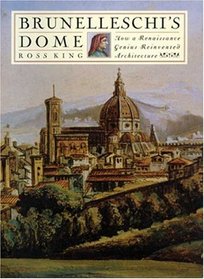Helpful Score: 4
Excellent. I really enjoyed it. You'll learn a lot. I think he mixes enough of the gossip, scandal and interesting bits of info from the day to keep it from getting too bogged down with details of the engineering and architectural feats.
Lorelie L. (artgal36) reviewed Brunelleschi's Dome : How a Renaissance Genius Reinvented Architecture on + 471 more book reviews
Helpful Score: 3
Filippo Brunelleschi's design for the dome of the cathedral of Santa Maria del Fiore in Florence remains one of the most towering achievements of Renaissance architecture. Completed in 1436, the dome remains a remarkable feat of design and engineering. Its span of more than 140 feet exceeds St Paul's in London and St Peter's in Rome, and even outdoes the Capitol in Washington, D.C., making it the largest dome ever constructed using bricks and mortar. The story of its creation and its brilliant but "hot-tempered" creator is told in Ross King's delightful Brunelleschi's Dome.
Both dome and architect offer King plenty of rich material. The story of the dome goes back to 1296, when work began on the cathedral, but it was only in 1420, when Brunelleschi won a competition over his bitter rival Lorenzo Ghiberti to design the daunting cupola, that work began in earnest. King weaves an engrossing tale from the political intrigue, personal jealousies, dramatic setbacks, and sheer inventive brilliance that led to the paranoid Filippo, "who was so proud of his inventions and so fearful of plagiarism," finally seeing his dome completed only months before his death. King argues that it was Brunelleschi's improvised brilliance in solving the problem of suspending the enormous cupola in bricks and mortar (painstakingly detailed with precise illustrations) that led him to "succeed in performing an engineering feat whose structural daring was without parallel." He tells a compelling, informed story, ranging from discussions of the construction of the bricks, mortar, and marble that made up the dome, to its subsequent use as a scientific instrument by the Florentine astronomer Paolo Toscanelli.
Both dome and architect offer King plenty of rich material. The story of the dome goes back to 1296, when work began on the cathedral, but it was only in 1420, when Brunelleschi won a competition over his bitter rival Lorenzo Ghiberti to design the daunting cupola, that work began in earnest. King weaves an engrossing tale from the political intrigue, personal jealousies, dramatic setbacks, and sheer inventive brilliance that led to the paranoid Filippo, "who was so proud of his inventions and so fearful of plagiarism," finally seeing his dome completed only months before his death. King argues that it was Brunelleschi's improvised brilliance in solving the problem of suspending the enormous cupola in bricks and mortar (painstakingly detailed with precise illustrations) that led him to "succeed in performing an engineering feat whose structural daring was without parallel." He tells a compelling, informed story, ranging from discussions of the construction of the bricks, mortar, and marble that made up the dome, to its subsequent use as a scientific instrument by the Florentine astronomer Paolo Toscanelli.
Helpful Score: 1
An engaging account of the political and technical challanges Brunelleschi faced building the first major dome of the Renaissance, and still largest masonry dome in the world after more than 500 years.
Helpful Score: 1
Nice illlustrations of the engineering principles during the Renaissance.
Helpful Score: 1
A truly fascinating account of the daring construction of the dome of the cathedral of Santa Maria del Fiore in Florence. Remaining to this day a marvel of architectural achievement, built without central support and in a size surpassing any other brick and mortar dome construction ever accomplished, in many ways it shouldn't have been possible. The genius of Brunelleschi in not only designing and overseeing the construction of the dome, but also constructing many new machines to aid in the construction, cannot be overstated. The perfection with which the dome was constructed is startling, as is the fact that in the decades he was in charge of the project, only one worker died in an on-site accident, a safety record virtually unheard of at that time in history. Though it can be a bit dry at times if you don't have a strong interest in architecture, it still remains a very good read if you have an interest in great historical achievements.




